
When somebody mentions keywords research, most people probably automatically think of an SEO (search engine optimisation) industry, right? Are you one of them?
You’ve come here to develop specialist eCommerce copywriting skills and have absolutely NO idea how keywords research relates to your goals and interests? Is it really necessary for a copywriter to bother with this, and if so – why?
You’ll find all the whys and hows if you read this lesson thoroughly to the end. There certainly are strong reasons why this topic is a part of your course.
The idea behind this lesson is not to turn you as a copywriter into an SEO master, but to provide you with a basic understanding of the following:
- what keywords are and which you should aim at,
- who uses them and why they’re useful,
- what keywords research is and how to conduct it successfully, quickly and easily,
- how you can use keywords in blogging for eCommerce and why you need them, as well as
- how it all relates to search engines.
It’s true that copywriters don’t have to be experts in keywords, but they still need to know enough to get by since keywords are quite important in eCommerce blogging. You wonder why? You’ll find a detailed answer down in the lesson.
For start, we’re just going to tell you that nothing can beat the combined marketing power of SEO and intelligently optimised purposeful content! Moreover, they’ve almost become equally important, if not playing the same role in influencing consumers and attaining the highest possible business goals.
But first things first! A definition of keywords and a comprehensive explanation about which ones to target, as well as who uses them follow.
What Are Keywords and Which Ones Should You Aim At?
Is a keyword a single word or a phrase consisting of a few words? Well, it can be both, actually. Based on their length, keywords are generally classified as:
- short tail keywords (those consisting of one to three words only, generic and broader terms, e.g. gazebo)
- long tail keywords (those usually longer than three words, narrower, more specific and targeted terms, e.g. deluxe gazebo with adjustable awning australia).
Now, you probably wonder which ones you should aim at including in your writing, right?
To figure that out, let’s type our example keywords into the Google search bar, see what we’ll get, and analyse the outcome.
Here are the Google search results for our short tail keyword (gazebo):
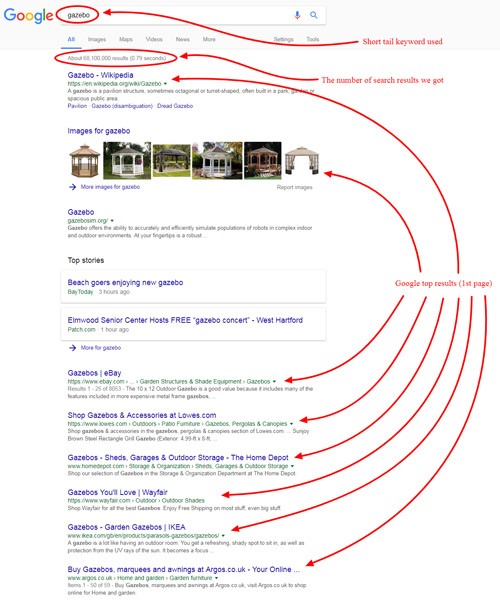
And here are the search results for its long tail pair (deluxe gazebo with adjustable awning australia):
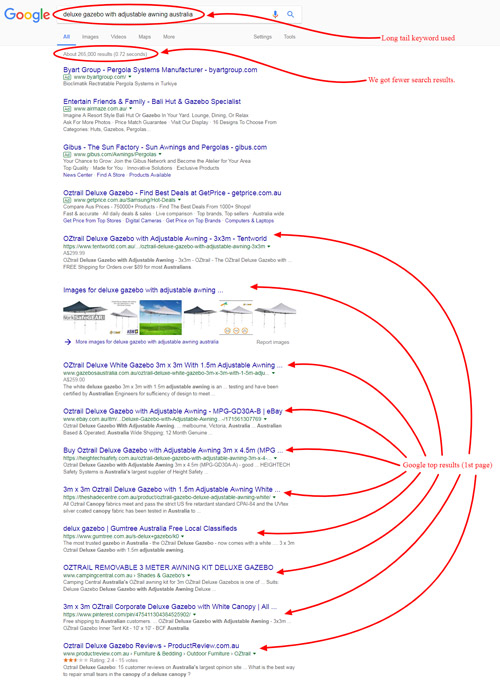
By taking a closer look at the search results (organic ones, not the paid ads) for both of our examples and comparing them, it’s inevitable to draw these conclusions:
- There are more results displayed for short tail keywords (68,100,000 as opposed to those for the long keyword – 265,000), which indicates that they are more popular, which also means the competition is higher.
- You can get far more specific, better-quality, and targeted results by using long tail keywords, which is more likely to ensure conversion since people know exactly what they’re searching for. People searching for ’gazebo’ are mostly just browsing, whereas those searching for ‘deluxe gazebo with adjustable awning australia’ are more likely to purchase.
- Based on the previous conclusion, using specific longer keywords is more profitable for an online store, and it also requires less effort and time to reach higher ranking in search engines and make the store visible to the right consumer. Thus it’s highly recommendable.
- It also means you shouldn’t be too concerned about the keywords popularity since providing traffic without the desired actions (purchase, sign-ups etc.) is nothing. Instead, you should strive for truly valuable keywords which will lead to some kind of conversion.
Moreover, here are some of the studies that support our conclusions above:
- https://searchenginewatch.com/sew/study/2214529/head-vs-long-tail-keywords-analyzed-impressions-clicks-conversions-profitability
- http://www.seerinteractive.com/blog/short-tail-vs-long-tail-keywords/
- https://searchenginewatch.com/sew/study/2132155/-page-optimization-dead-tail-keywords-increase-rankings-conversions-study
All in all, both keyword types have their advantages and disadvantages. That’s why the best recommendable practice would be to balance between using both short and long tail keywords depending on whether you want to focus on getting more traffic and improving the website ranking (short tail), or achieving the desired conversions (long tail).
For instance, perhaps it would be smart to opt for shorter keywords in product and blog post titles, whereas long tail keywords could be best fitted into the body of a blog article or a product description.
Also, you can easily incorporate short tail keywords into your long tail ones. Isn’t it a win-win situation which will help you conquer both the search engines and your competition?
Whatever you decide, ALWAYS make sure the keywords you’re using are highly relevant and original. Also, try to express yourself as naturally as possible when incorporating those keywords into your writing, and stay away from keyword stuffing. Got it?
Another big question is who uses keywords. So, let’s see!
Who Uses Keywords?
Both search engines and customers use keywords.
OK, you’ve figured out that people use keywords to find a product or anything else on the Internet and you basically understand how they do it. But how do search engines use keywords? Well, they match them to what the customers are looking for and they try to give them the best result.
Naturally, every online store wants to show up at the top of the search engine results, and your job is to do your best to achieve that by including the most appropriate, popular, and relevant keywords in the content you create.
Not only that! Your primary goal is to urge the readers to convert, that is to say, to:
- leave their contact details,
- download something from your website,
- leave comments,
- share your content,
- subscribe to your newsletter, or – if you’re skillful and lucky enough –
- to purchase the products you’re advertising.
That’s why you as a copywriter MUST know how to use keywords and which ones to choose (but we’re going to talk about that in detail a bit later).
What’s more, to hit those targeted keywords which will help you achieve the desired conversion you MUST TRULY UNDERSTAND a reader’s real intention behind the keywords they type in (a.k.a. user intent or buyer intent, in the eCommerce industry), that is to say, their motivation, needs, and demands, as well as their importance in the era of semantic search.
For those who want to find out much more about semantic keywords research, examples, tools, and its advantages, here are some further reading suggestions:
- What Is Semantic Search and Why Should I Care?
- How to Create Smarter Content Using Semantic Keyword Research
- 5 Tips for Conducting Semantic Keyword Research
- How to Improve Your Rankings with Semantic Keyword Research
- The Best Guide to Semantic Keyword Research
Furthermore, it’s essential for you to understand why your keyword strategy is incomplete without focusing on user intent.
Historically, people just used to put their keywords into a page e.g. 5,000 times which was enough for emerging at the top of search engine results. Those keywords were used by search engines to denote the relevance of a certain page to a particular keyword.
However, the times have significantly changed and it’s all far more nuanced these days.
That brings us to the next topic – the specific reasons why eCommerce copywriters would use keywords and have to know anything about their proper use at all.
Why Do eCommerce Bloggers Have to Use Keywords?
You’ve already grasped the main point – your job as a copywriter is to write valuable content (such as blog articles or product descriptions) to promote all the products that the online store you’re working for is selling.
Moreover, to achieve outstanding results (hopefully selling the products) and earn higher rates, you must know how to choose highly relevant and valuable keywords and include them in your great content.
OK. But you’re still not convinced why you would have to do that? Isn’t it enough to know the topic and just sit down and write that amazing article without too much thinking about what exact words to use?
Well, if you still wonder why, you haven’t read the article about the most important features of great content we linked to above!
The #1 characteristic of any great content is findability! Without it, it’s totally worthless because people will NOT even know your blog article exists!
So, you must admit that it’s pointless to have a marvellous persuasive piece of content unless it’s visible to your target reader, right?
How do readers find your content on the web, then?
They usually type some words in Google search, right? Those words are what you need to include in your content while creating it to perfectly match your target audience’s search queries.
Do the keywords eCommerce bloggers use differ from the others? YES! How? Here’s how.
Keywords typically used in the eCommerce industry tend to include a specific type of action words (mostly verbs) such as:
- BUY,
- GET,
- SHOP,
- PURCHASE, or
- FOR SALE.
This is relevant because the buyer intent is very particular since the words included are not e.g. ‘make’ or ‘craft’. (We’re going to show you how these words considerably influence your search results a bit later)
Therefore, copywriters must tend to get more specific because customers searching for more specific keywords are also more likely to buy, remember?
Still not convinced and sure why it matters a great deal?
Because these keywords you use are exactly what attracts potential customers and directs them to your store. That’s how they’ll find it on the Internet, so you must know how to meet your customers’ demands and help them find you effortlessly.
In other words, you must be aware of the phrases they type in Google search to look for the products your employer is selling so that you can find the opportunities to effectively promote the store online. Got it?
Now when you can clearly see the point, let’s dive deeper into the secrets of creating valuable keywords lists and conducting successful keywords research.
Why Creating a Good Keywords List Is Important?
Creating a thorough list consisting of valuable and relevant keywords is super handy because it will provide you with plenty of ideas on what exactly to write about for a particular product or blog post.
Organising your ideas and saving them in a spreadsheet will also help you come up with the titles for your articles faster and easier. Just make sure all the information you gather is clearly and neatly organised and you’ll save much time and effort when you start writing.
Mind you, you are NOT supposed to write for your entire industry overall, nor let’s say, for a type of broad product category at once, but to create a piece of content for e.g. a single specific product.
In other words, you’ll analyse trends and learn about what your market demands from your products, as well as your competitors so that you can stand out from them. Choose the most relevant and natural keywords without too much thinking.
Naturally, you’ll make sure what you’re writing about exactly or closely matches to a keyword you choose from your list. Once you identify the terms people are searching for and start shaping your writing according to these gems, you’ll finally be able to genuinely and actively connect with your audience and make them convert.
Nevertheless, there are certain questions imposing themselves here:
- How to find those specific precious keywords that suit your content marketing goals and which are the best to use?
- How to create a valuable keyword list?
Figuring out the answers to these questions is closely related to conducting an extensive keywords research as painlessly as possible. So, let’s dig deeper into its strategies.
How to Conduct Successful Keyword Research Quickly and Easily?
So far you’ve realised that if you want to be savvy in blogging and content marketing, you have to use keyword research in order to find the most suitable keywords or keyphrases that are being searched by online users.
No one said it’s fun and easy, but it’s undoubtedly necessary!
By doing this you get the information:
- what exactly people are searching, and
- how you can use these high-demand keywords in creating great blog posts or any other content.
Keywords are those words that people type in their browsers in order to find what they want online, remember?
Thus, conducting keywords research is inestimable since you can use that information to help you understand what customers are actually looking for and determine opportunities like a new sideline product or a new product feature to add to the store.
Here’s exactly how an online store can benefit from thorough keyword research.
As an example, let’s say you work for a store selling gazebos and none of you knew that most of your customers refer to ‘market gazebos’ as ‘market umbrellas’.
Luckily, by working through the keyword research you were able to learn that there was more demand for ‘market umbrellas’. Now, you can change the category names and use the term ‘market umbrellas’ in the store to attract more customers.
Also, let’s say that you’ve realised that there is an opportunity to promote ‘gazebo spare parts’ more than you would ordinarily do.
For instance, initially you offered spare parts as a customer courtesy, but discovered during the keyword research phase that there was far more demand for spare parts than you had thought.
This enables you then to create store pages with far more information about the spare parts and also offer a larger range of products. The result will probably be more and more sales coming from the spare parts.
You see? Now imagine how your employer is going to be grateful for that!
However, in order to achieve similar results, you should first come up with a list of keywords specially relevant to your store’s products. In order to work them out, there are several steps to follow while doing research.
Nevertheless, this process is not an exact science so there are various ways of doing it. There are also numerous tools SEO experts use, but we’re going to focus mostly on a few free and simple ones a novice in copywriting could benefit from.
All in all, you are not obliged to stick to these steps only. The main goal is to give you some simple ideas about where and how to find keyword variations, and to help you understand the purpose behind the whole process.
Step 1: Write Some Keywords Right off the Top of Your Head
For start, you’ll just write down everything you can think of when it comes to popular words and phrases people are typing in search engines when looking for products you should write about.
That’s right – use your common sense! Put yourself in your customer’s shoes and come up with some relevant keywords right off the top of your head.
The starting point is to think what it is that you’re trying to sell with your copy. Is it a ‘gazebo’, for example? OK. The term is pretty generic, isn’t it? How can you narrow down the search?
Well, you might get down into the brand area, moving from the broad term to a very specific phrase, such as ‘OZtrail gazebo’.
You might get even more specific by including some other special product features, for instance ‘OZtrail deluxe gazebo’, or even the desired product dimensions, e.g. ‘OZtrail deluxe gazebo 3m x 3m’. You may also include location such as ‘OZtrail deluxe gazebo australia’, and the like.
Whatever occurs to you, just keep thinking like your customers do while they’re searching the Internet with the intention to buy a product your store owner’s selling.
But when someone wants to make a purchase, wouldn’t they indicate their buyer intent by actually using those active verbs? How about ‘buy OZtrail deluxe gazebo 3m x 3m’? Sounds better?
In eCommerce it’s important to use words such as ‘buy’ because they change the search results since it’s clear a person’s intention is to buy and not to e.g. make anything. Remember?
Take a look at how our search results are different with and without this specific word related to our planned action.
Here’s what we get when the word ‘buy’ in NOT included in our search term but we search only for ‘oztrail deluxe gazebo 3x3m’.
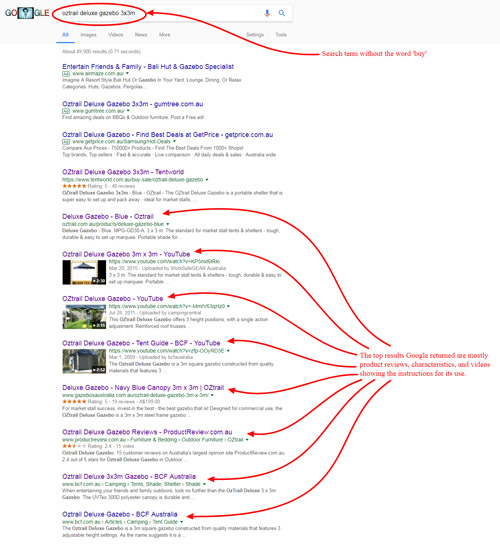
The first page organic results mostly include product reviews, characteristics, and videos demonstrating its use.
On the other hand, here are the organic results Google returns when we include the specific action word ‘buy’ in our search term.
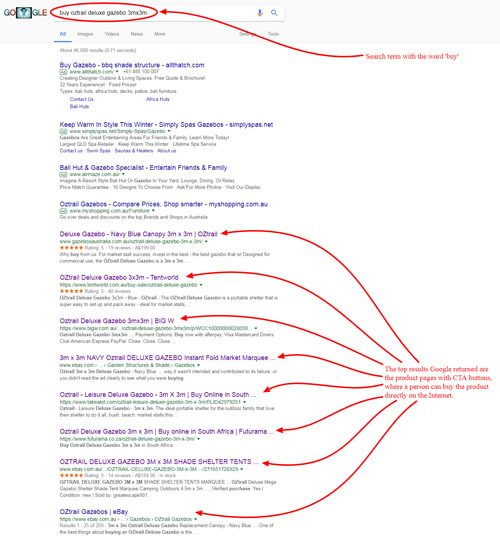
After checking the results, it’s noticeable that this group of pages are actually all product pages which also include prominent CTA (call-to-action) buttons which enable a visitor of each page to directly shop for the product online.
So, it’s evident that keywords really control what happens in the search engines and whether ads or certain websites (blog articles, online shops, product listings etc.) are shown or not.
This again proves that the way you structure your keywords is extremely significant.
To summarise the point, when you start considering what you should be writing about as an eCommerce copywriter trying to sell products, make sure you always have that buyer intent on your mind and include those specific action words in your keyword phrase.
Consequently, instead of using generic phrases such as ‘gazebos’ or ‘best gazebos’, you would aim at the more specific ones, such as for instance:
- ‘how to buy a portable gazebo’,
- ‘which is the best gazebo to buy for a big family’,
- ‘a guide for gazebo purchase’
- ‘where to buy big gazebos’,
- ‘how to purchase small gazebos’,
- ‘best australian gazebos for sale’,
- ‘where to purchase market umbrellas’ or
- ‘buyers’ tips for gazebos’, and the like.
Got it? Don’t forget that these keyword phrases can serve as excellent starters and triggers for your blog post headlines, as well.
If the store you’re working for sells hundreds or thousands of products, you’ll end up with loads of keywords following the procedure explained in this subsection. Just relax, start from the generic ones and move to those more specific, but make sure they’re natural and highly relevant.
Great! Now, is there anything that could help you organise those ideas? Sure.
Step 2: List All the Products and Keywords per Category
Now that you have dozens of keywords on your list, it’s time to better organise them so that you can easily find them when you need them, right?
Instead of just putting those keywords into your spreadsheet, it would be better to group them somehow, wouldn’t it?
One way of doing so is to group all the products and the corresponding keywords per category and put them in separate sheets. Of course, you’ll do whatever suits you best and makes it easier to manage that information and navigate through your spreadsheet later.
What else can you do to generate more keyword ideas? You’ll be surprised how simple yet effective ways there are to do so. Just keep reading.
Step 3: List All Keywords Mentioned in Google Suggestions or Autocomplete
When you’ve written down some basic keywords combinations and organised the most useful ones into categories, you’ll use them as a basis for further research.
Here’s a simple yet clever trick of the trade. Remember when you type words in the Google search box how it offers you suggestions along the way? That’s the option you’ll find helpful now – Google Autocomplete or Google Autosuggest, or whatever people call it.
Namely, open a Google search page (you can even choose the page of a country you’re most interested in, e.g. https://www.google.com.au/ for Australia). Now you’re ready to start the procedure. You’ll see how simple it is.
Type or copy the first basic keyword from your spreadsheet into the Google search box. Hit the spacebar, and then type in the letter ‘a’ but DON’T press Enter or click on the Search button. This is how you’ll get automatic suggestions that start with your phrase and continue with the letter ‘a’.
For instance, let’s take the keyword ‘gazebo’, apply the steps above and see what we’ll get in the Australia Google search page.
Here are the results for letter ‘a’.
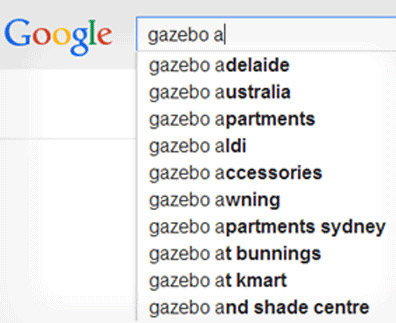
And here are the results for letter ‘b’.
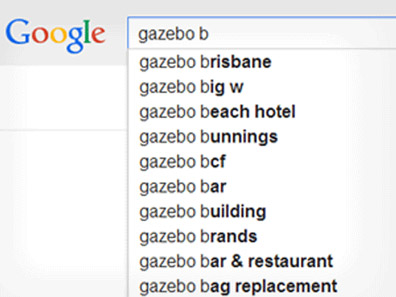
If you please,you can continue doing this for all the letters of the alphabet. In other words, repeat the same process for all the combinations of the letters and the basic keywords you have.
Amazing, isn’t it? Here are more similar tips and tricks that will make your life easier.
Step 4: List All Keywords Mentioned in Bing or Google Related Searches
You simply cannot think of all variations yourself so it’s important to follow these kinds of steps which will help you uncover numerous great keywords for your pages.
So, visit Google and type the first keyword from your initial list in the Search box. Then, scroll to the bottom of the page and see the related searches.
Choose the useful suggestions and copy them into your spreadsheet, and that’s it. Can’t believe how simple it is? More than super easy, indeed!
You can repeat this process with all the keywords from your basic list.
Let’s demonstrate how it works on an example! We’ll search for the term ‘deluxe gazebo canopy’. Here are the related searches.
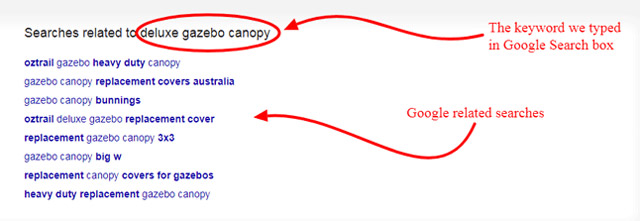
What’s more, you can do the same thing within another search engine such as Bing. Scroll down and check the related searches. Again, do this for all the core keywords you’ve come up with and extract the new suitable ideas into your spreadsheet.
Don’t copy those not relevant or valuable enough because you’ll just pollute your list and waste precious time on keywords that you won’t use anyway.
At this point, you’ll probably have over a hundred useful keyword combinations. Wow!
But, that’s not even close to the end of the road! Here’s more!
Step 5: Put Those Keywords in Tools Like Ubersuggest to Find Other Variations
Ubersuggest is just one of the tools specialised to help you get keywords variations you haven’t thought of yourself.
Although it may sometimes be very monotonous and require a lot of focus, be thorough and stick to the process so that you don’t miss on any great keyword variations because you may find fantastic opportunities there.
Let’s check this tool out!
Take a look at just a small part of the whole bunch of variations we got for almost every letter of the alphabet when we searched only for a very basic and generic keyword – ‘deluxe gazebo’.
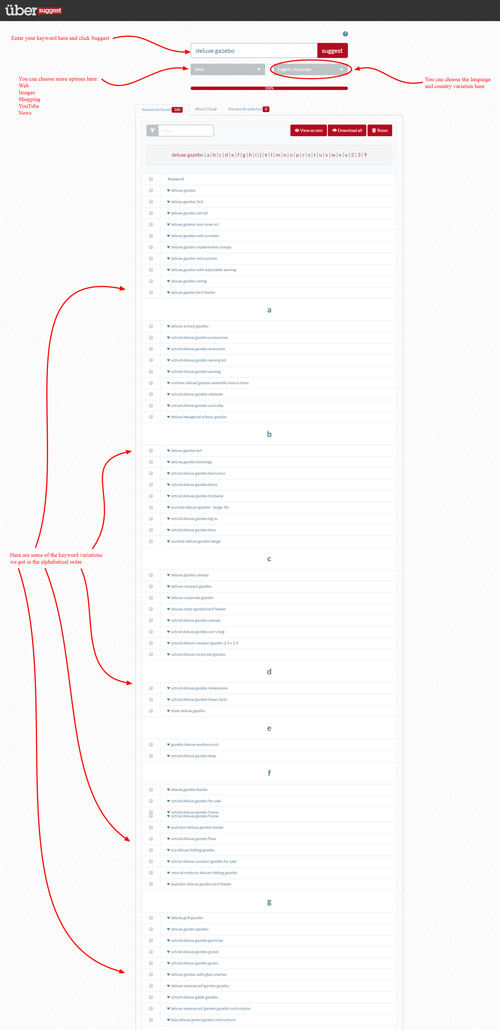
You see how powerful this tool is?
Therefore, select the relevant country, copy down your first basic phrase in the search box and click ‘Suggest’. Then, transfer the best ones to your spreadsheet. Again, repeat the same for all the core keywords you’ve initially come up with.
Remember – consider only the relevant keywords and organise your spreadsheet as you like.
Step 6: Check Your Keywords Popularity Using Google Trends
Google Trends is an online keywords research tool that shows how often a keyword or term is searched in relation to the total search volume in different areas. This is an excellent and versatile tool for Search Engine Optimisation (SEO) that will help you determine if your keywords are being used by people to look for your products/services.
Here’s what this fabulous tool offers to its users.
How to use Google Trends
When accessing Google Trends to do some keywords search, you can set different parameters or filters to narrow down the results to get accurate and specific figures.

- Worldwide option lets you search results from different locations, countries or limit them to a specific state only.
- Past 12 months option lets you search results with a specified date or time frame.
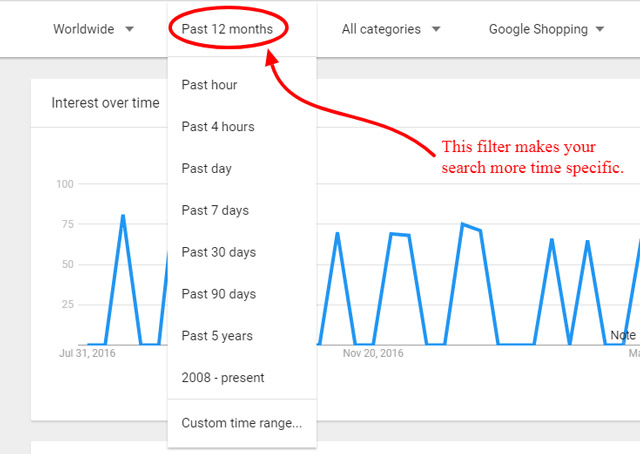
- Web Search option lets you specify which type of results you want to find.

Moreover, you can search for a keyword or term and compare up to 5 search terms or groups at a time with up to 25 search terms in each group. You can use the + sign between your search terms if you want to add more than one term in a search.
Now, let’s check how it works! We’re going to compare three keywords (‘market umbrella’, market gazebo’, and ‘portable gazebo’) and apply different filters to our search. Sit back and carefully watch the incredible changes in the results as we switch search options.
Isn’t this tool fabulous? And this is just a part of what it can do to help you! Go ahead, explore it further yourself!
What’s more, this tool also has Trending Searches and Top Charts options which are updated from time to time.
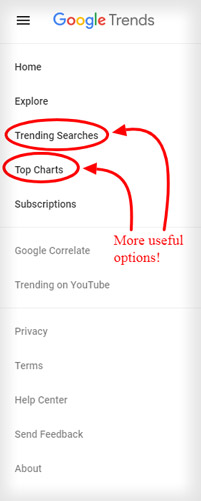
What are you waiting for?! Go ahead! Play with these options to see how they work! You’ll have fun for sure! Then, who said that keywords research is boring?!
Anyway, all the information offered in Google Trends is precious especially when you know the demands of your potential customers and use the data you gather for building your powerful SEO and content marketing strategy.
So, what can we find out from this cute little tool? Let’s see.
What Google Trends Tells Us
Google Trends gives us valuable information that we can already draw conclusive ideas just by looking at the charts alone. Knowing which keywords are best to draw the customer’s interests, you can use Google Trends to find which features of a product the buyers might be interested in more. These keywords can be used for branding and advertising.
So, based on the data we got (below), should we use ‘market umbrella’, ‘market gazebo’, or perhaps ‘portable gazebo’?
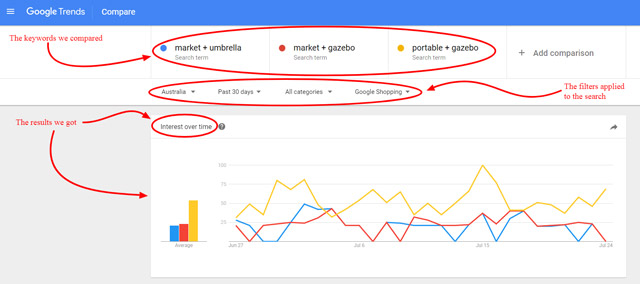
What do you think? ‘Portable gazebo’, right? Yes, it should certainly be the starting point for building your long tail keywords list.
Therefore, go to Google Trends and type in the keywords from your list. You will get a graph of the volume certain keywords had over time. That’s how you will see whether those keywords are trending up or down. Ideally, they are trending up or at least are not trending down heavily.
This is important because you don’t want to invest in some keywords for the next few months if that keyword is losing popularity rapidly. It doesn’t matter if you are ranked high, when people just stopped searching for it.
You can also add a ‘Trending’ column to your keyword list in the spreadsheet, and type in whether a certain keyword is trending up or down.
As you can see, Google Trends also gives you the relevant data about which demographic groups are most interested in your keywords a.k.a. Geo-Targeting. This indicates which state/region has the strongest potential markets for your products. Also, this valuable information makes it easy for the store to find possible market locations especially when your employer’s planning to expand the business.
In a nutshell, mastering this tool will surely give you an edge over your competitors!
Now that you have the most important data you are ready to pair them with your website pages. However, if you pair your page with an irrelevant keyword and get a lot of traffic, it just won’t result in sales because you are getting people that are searching for something else.
So, the main question is when you write a whole bunch of those keywords, how do you know which ones to use? Here’s the answer.
Step 7: Make Sure You Use Highly Relevant Keywords
By following the steps we’ve presented above, you’ll probably end up with hundreds of keywords combinations, but that’s NOT what you need or want, is it? You just want to see which ones you should be using, right?
Actually, it can turn out to be only a handful of the most relevant keywords, which are at the same time popular enough.
Therefore, be careful NOT to pollute your keywords list!
Relevancy is particularly vital so that you wouldn’t write, for instance, an article about running shoes for a gazebo store because these products have no connection whatsoever.
Remember how Google tends to provide a match when a customer types in a phrase in the search bar? If they search for e.g. ‘small gazebos for sale’ and your article goes all about that topic including the same keyword, then it’s a perfectly relevant match. As simple as that!
Moreover, be extra careful about a keyword popularity. Just because a keyword is popular, it doesn’t mean that you should write about it. Thus, you need to look carefully at the keywords that you’ve got in your list, and think about whether they actually match the specific product you’ll write an article about. Got it?
Always remember that you have to really make 100% sure the keyword you’re using is HIGHLY RELEVANT! To summarise, your ultimate goal is to hit the best possible balance, that is to say, to discover those high-volume low-competition keywords to incorporate into your content.
Keyword research and blogging are constant actions in your ecommerce store activities, which means you will exhaust your list of keywords for blogging and you will have to revisit it and find new phrases.
But, don’t worry! You can repeat this process as much as you like or need. In addition, we presented you with some most basic tools in this lesson.
However, there are much more complex ones SEO experts use, so you can also find those if you want. It’s not that you need them, but you just have them on your disposal, too, in case you want to explore them.
Whatever path you decide to take, it is very important to keep your content creating strategy going because Google values it very highly.
So, provide top-quality content often and you will be rewarded.
In Summary
A keyword can be a single word or a phrase consisting of a few words, both customers and search engines use to find a product (or anything else) on the Internet.
If you want to intelligently optimise purposeful content, tend to incorporate short tail keywords into the long tail ones and into e.g. your product or blog post titles, subheadings, image ALT Attributes, or file names, whereas long tail keywords should be included e.g. in the body of your article or product description as naturally as possible.
When promoting online store’s products, eCommerce copywriters must use specific action words as part of their keywords (such as buy, purchase, for sale, shop, get, and the like) within a compelling piece of content that will urge the reader to convert. They must also always be aware of the buyer intent.
In order to genuinely connect with your target audience and make them convert, you need to write highly relevant and truly valuable content for the store’s website.
Creating a valuable keywords list can help you save a lot of precious time and effort by providing you with plenty of ideas on what to write about.
However, if you want to compile a good keywords list, you must do thorough keywords research first.
Here are some simple steps that will help you conduct your keywords research successfully and easily:
- Write down keywords you would use to find your products off the top of your head.
- List all your products and keywords per category.
- List all keywords mentioned in Google suggestions/Autocomplete.
- List all keywords mentioned in Bing and Google related searches.
- Put those keywords in tools like Ubersuggest to find other variations.
- Check your keywords popularity using Google Trends. Google trend gives you a comparative interest over time for a potential keyword phrase as well as comparing the level of interest among prospective target phrases, which is of inestimable help in content marketing and SEO.
- This way, it enables you to finalise your keywords research by choosing highly relevant keywords that have been steadily popular for months or even years.
OK. it’s time for you to demonstrate your knowledge now! Ready? Sure you are!
